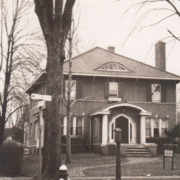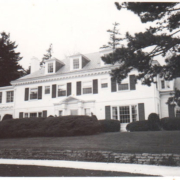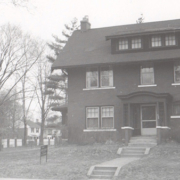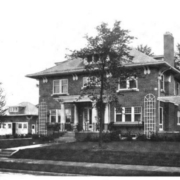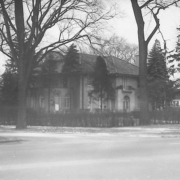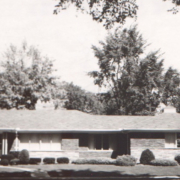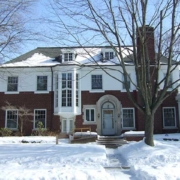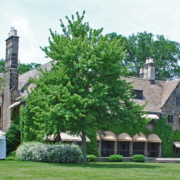Historical Architecture of Grosse Pointe – An Exploration – Part 3: Westchester 2nd block
Having previewed the myriad of architectural styles on display on the 1st block of Westchester we continue our journey down the street as we explore the 2nd block – between Fairfax and Exeter.
Many residences on the first block were created during the golden era of the 1920’s, however the homes on the second block span several decades. Primarily the 1920’s through to 1940, the broader range of influences come from numerous different movements and eras – there is the Art Deco styled modern home at number 766, the excellent example of a classic Georgian Colonial home, number 895, the Tudor inspired home of 718 and the French Provincial style of house number 705.
So lets begin with one of the older homes on the block, house number 705. Designed in the French Provincial style the 3,306 sq ft house was built in 1921. Constructed of brick, like many homes from this era, the design demonstrates several distinctive characteristics of this style, including the tall second story windows that are arched at the top, a steep roof with a tall rectangular slender chimney along with wrought iron detailing.
House number 899, a 2,300 sq ft English inspired residence, was designed by renowned architect Richard H. Marr in 1923. Marr created numerous Tudor Revival and English country manor inspired residences throughout Grosse Pointe including 740 Whittier, 1009 Three Mild Drive and 905 Balfour (to name but a few). Richard Marr was known as the “Architect of the Midwest Millionaires”, creating upper end homes for some of Detroit’s wealthiest families.
House numbers 806 and 895 were both built in 1926. Number 806 is arguably one of the more distinctive homes in Grosse Pointe. The composition of the front façade has a delicate touch; the symmetrical design has a collection of semi-circular elements including the windows on the first floor, along with the singular dormer in the roof with its decorative motif.
Number 895 evokes a classical Georgian Colonial approach. The symmetrical design features a center entrance; large windows on the main floors along with the small dormer windows in the roof – all common traits of this architectural style. This 2,669 sq ft house is constructed from brick – it was a very popular style in the community during this era and there are plenty of fine examples around Grosse Pointe.
House number 726 was built in 1927. Designed by the Detroit architectural firm of Mildner & Eisen it is an English style 2,600 sq ft residence constructed of brick, with an intricate rope detail carved into the limestone around the front door. Mildner & Eisen created several building in Detroit, including the Goeschel Building in 1914 (E. Gratiot Ave.) and the Pochelon Building located at 815 Bates Street. They also specialized in the design of brewery buildings in both the United States and Canada.
Number 898 could possibly lay claim to Grosse Pointe’s ‘most unique’ entrance. The front entrance Colonial, built in 1928, features a tile roof and a rather charming central eyebrow dormer.
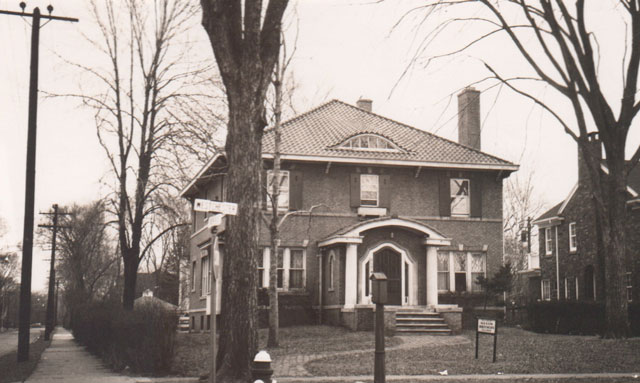
Moving into the 1930’s, up next is house number 701.The brick colonial, designed by Detroit architectural firm Herman & Simons, is 3,492 sq ft and is a great example of how details matter. The vertical copper gutters, instead of hindering the composition, make for an exceptional design feature. Herman & Simons were involved with the design of numerous churches, banks and schools in Southeastern Michigan
House number 766 is a superb example of an art deco home. Constructed in 1937, it is 3,272 sq ft, constructed of light colored sandstone, and features some classic period detailing on the front door.
There are several superb Art Deco homes in Grosse Pointe, including 705 Pemberton, Grosse Pointe Park, which was designed by Lyle F. Zisler. Mr. Zisler was also responsible for another remarkable art deco residence in Grosse Pointe Woods, which can be found at 641 South Oxford.
Art Deco was extremely popular in Detroit during this era; the city is home to some of the most ‘elegant and exotic Art Deco structures in the United States’. Source: Art Deco in Detroit, by Rebecca Binno.
Finally house number 718 is one of the newer homes on the block. Built in 1940 this is certainly a classic Tudor design, but it also has several intriguing components including some very heavy features – in particular the half timbering area, along with the chimney. What makes this home interesting are the unusual curves on the half timbered section on the second floor along with the thick double brackets below the main window of this area.
Like so many residences in Grosse Pointe, its the distinctive homes like these on Westchester that help make the architectural scene in the community so compelling. We will be featuring more streets over the coming weeks.
*Photos courtesy of the Higbie Maxon Agney archives unless stated.
Written by Katie Doelle
Copyright © 2016 Katie Doelle

